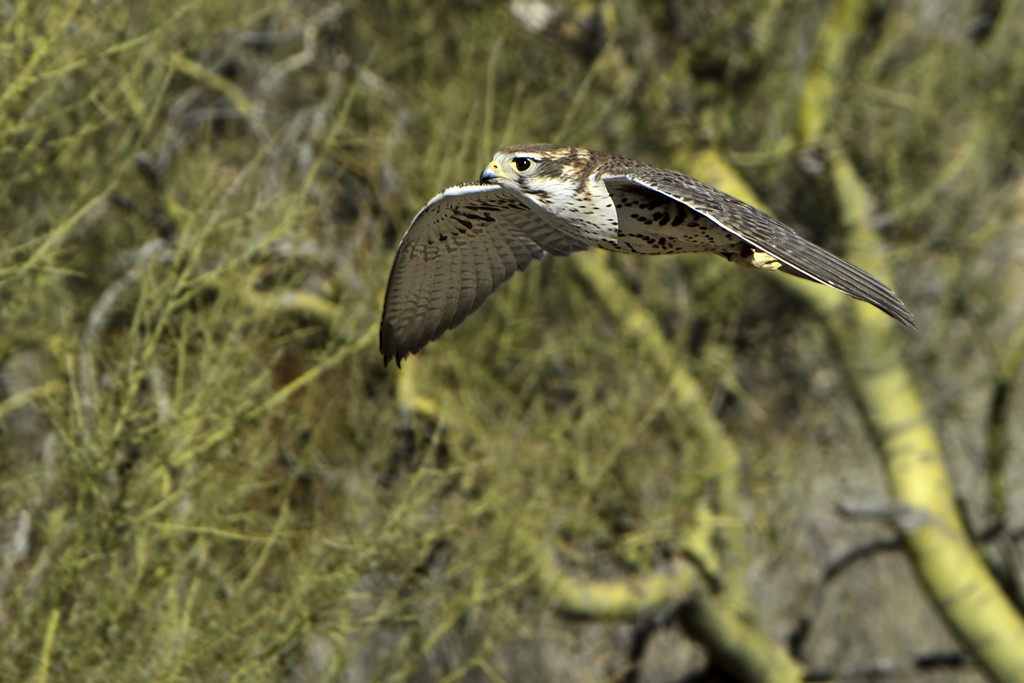Prairie Falcon
A species of True Falcons Scientific name : Falco mexicanus Genus : True Falcons
Prairie Falcon, A species of True Falcons
Botanical name: Falco mexicanus
Genus: True Falcons
Content
Description People often ask General Info
Description
The prairie falcon (Falco mexicanus) is a medium-large sized falcon of western North America. It is about the size of a peregrine falcon or a crow, with an average length of 40 cm (16 in), wingspan of approximately 1 meter (40 in), and average weight of 720 g (1.6 lb). As in all falcons, females are noticeably bigger than males. Though a separate species from the peregrine, the prairie falcon is basically an arid environment adaptation of the early peregrine falcon lineage, able to subsist on less food than the peregrine, and generally lighter in weight than a peregrine of similar wing span. Having evolved in a harsh desert environment with low prey density, the prairie falcon has developed into an aggressive and opportunistic hunter of a wide range of both mammal and bird prey. It will regularly take prey from the size of sparrows to approximately its own weight, and occasionally much larger. It is the only larger falcon native only to North America. It is resident from southern Canada, through western United States, and into northern Mexico. The prairie falcon is popular as a falconry bird, where with proper training it is regarded as being as effective as the more well known peregrine falcon. 
Size
38-48 cm (15-19 in)
Colors
Brown
Black
Gray
White
Life Expectancy
15 years
Nest Placement
Cliff
Clutch Size
2 - 6 eggs
Incubation Period
1 brood
Number of Broods
29 - 39 days
Nestling Period
29 - 47 days
Feeding Habits
Prairie Falcon's diet primarily consists of small mammals like ground squirrels. They also consume pikas, birds, insects, shorebirds, and doves. In winter, prairie Falcon mainly feeds on Horned Larks and Western Meadowlarks. It caches excess prey and has documented instances of carrying prey up to 70% of its body weight, though most are 150g or less. Prairie Falcon occasionally preys on large birds and even consumes reptiles.
Habitat
Prairie Falcon's habitat spans open terrains like alpine tundra, arid grasslands, and deserts, with a preference for areas that include cliffs or bluffs for nesting, up to altitudes of roughly 11,000 feet. These raptors require regions with abundant prey and may seasonally relocate to lower, milder environments such as plains and basins during winter.
Nest Behavior
Prior to egg-laying, prairie Falcon spends over a month site-selecting with its mate, using existing depressions or others' nests for its eggs. Parental care includes using high, inaccessible places to safeguard against threats.
Nest Characteristics
Prairie Falcon chooses cliffs or steep bluffs with overhangs for natural crevices or ledges to nest, protecting against predators. Some nests are on structures like powerlines or buildings. They use minimal materials, often just scratching a depression for eggs.
Dite type
Avivorous
People often ask
General Info
Feeding Habits
Bird food type
Behavior
Prairie Falcon engage in a dynamic and strategic pursuit for food, with their flight characterized by flat or slightly dipped wings and curled wingtips. They demonstrate remarkable agility with short, rapid wingbeats, especially evident in males. Prairie Falcon extensively interact with their environment, utilizing perches and low-altitude flights as hunting strategies to ambush prey with a surprise glide or high-speed stoop. Pair bonding and territorial defense are critical aspects of their behavior, with coupled prairie Falcon engaging in month-long courtship displays and vocalizations near selected nesting sites. Territorial patrolling is a vigilant daily activity during breeding seasons, with prairie Falcon aggressively excluding intruders with coordinated attacks and distinct alarm calls. Post-breeding season behavior shifts from direct migration to an exploratory phase before proceeding to winter habitats.
Distribution Area
The natural habitat of the prairie falcon is open country, especially arid, in summer including alpine tundra to shortgrass prairie and high desert. In winter it is more widespread, ranging to low deserts and occasionally to towns. It breeds from southern Manitoba, Saskatchewan, Alberta and south-central British Columbia south through the western United States–roughly between the eastern edge of the Mountain Time Zone and the Cascade Mountains, as well as the Central Valley of California–to the Mexican states of Baja California, Durango, and northern San Luis Potosí. It is much less migratory than the other North American falcons, but in winter it does withdraw somewhat from the northernmost and highest-elevation parts of its breeding range and spreads west to the deserts and Pacific coast of California, east to about the 100th meridian, and south to Baja California Sur, Jalisco, and Hidalgo. 
Species Status
Due to this species' large range and apparently increasing population, it has been classified by the IUCN as least concern. However, it has experienced some local declines in Texas, California, and Alberta as grasslands are developed for agriculture, cities, and other human uses. Such a decline could result in an inability for birds to find mates or suitable habitat. 
Scientific Classification
Phylum
Chordates Class
Birds Order
Diurnal Birds of Prey Family
Falcons and caracaras Genus
True Falcons Species
Prairie Falcon 